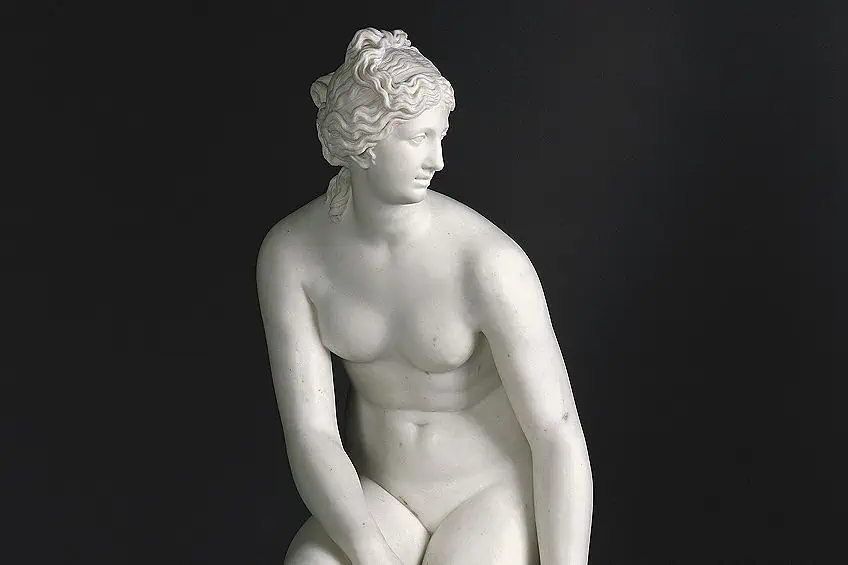Famous Neoclassical Sculptures – Explore Neoclassical Statues
What is Neoclassicism? And what are some of the best Neoclassical sculptures? In this article, we will explore the intriguing world of Neoclassical sculpture and the Western-European cultural movement that informed the birth of some of the most famous Neoclassical sculptures in art history.
Contents
- 1 Neoclassicism
- 2 Top 15 Most Famous Neoclassical Sculptures
- 2.1 Bather (1757) by Étienne-Maurice Falconet
- 2.2 Venus (1773) by Joseph Nollekens
- 2.3 The Death of Germanicus (c.1774) by Thomas Banks
- 2.4 Father Thames as a River God (1779) by John Bacon
- 2.5 Diana the Huntress (1782) by Jean-Antoine Houdon
- 2.6 Princesses Monument (1795 – 1797) by Johann Gottfried Schadow
- 2.7 Venus Victrix (1804 – 1808) by Antonio Canova
- 2.8 Head of the Nymph (1809) by William Rush
- 2.9 St. Michael Overcoming Satan (1819 – 1824) by John Flaxman
- 2.10 Monument of Józef Poniatowski (1826 – 1827) by Bertel Thorvaldse
- 2.11 Lesbia and Her Sparrow (1836) by Johann Heinrich Von Dannecker
- 2.12 George Washington (1841) by Horatio Greenough
- 2.13 Nydia, the Blind Flower Girl from Pompeii (1853 – 1854) by Randolph Rogers
- 2.14 The Greek Slave (1869) by Hiram Powers
- 2.15 Daniel Webster (1858) by Hiram Powers
- 3 Frequently Asked Questions
Neoclassicism
The Neoclassical movement was a cultural movement across the West and Europe that played a huge role in redefining the artistic and stylistic focus of many humanitarian disciplines, including architecture, literature, music, and art. It is important to remember that this shift in style was predominantly inspired by the artistic styles and myths of Classical Antiquity, which were driven by popular Greco-Roman mythology and legends.

So, what is Neoclassicism? Neoclassicism originated in Rome during the rediscovery of Herculaneum and Pompeii. The Neoclassical movement was widespread and coincided with one of the largest cultural shifts in history, the Age of Enlightenment, which occurred around the 18th century. While the art style of Neoclassicism lasted throughout the 19th century in sculpture, its longevity was felt in architecture well into the 21st century.
An Introduction to Neoclassical Sculpture
In Europe, Neoclassicism emerged around 1760 as a preferred style to the then-dominant rococo art style. While the rococo style prioritized a sense of ornamentation, asymmetry, and elegance, the Neoclassical art style preferred simpler designs, which were founded on the principles of symmetry and simplicity. In a sense, the rise of Neoclassicism was a return to the old “virtues” of art as found in ancient Greek and Roman art. The “neo” in Neoclassicism was the selection of a few classical models that artists or architects chose out of their options from antiquity and rejected the rest.
Between 1765 and 1830, Neoclassical practitioners in the visual arts as well as collectors of Neoclassical artwork focused on an idea that promoted a generation of Phidias.
Phidias was one of the most famous Greek artists and sculptors from ancient Greece who is credited with creating the world-renown Statue of Zeus at Olympia. The group of Neoclassical practitioners then switched over to emulating the styles found in Roman copies of Hellenistic Greek sculptures. Artworks from Archaic Greece and the Late Antiquity period were ignored. Thus, one can say that Neoclassical art was quite specific and would have varied in subject matter for each Neoclassical practitioner. It was, in a sense, a divergent movement forward from a very specific genre of art.

Another key art style of the Neoclassicism movement was the Empire style, which was rooted primarily in the decorative arts and architecture. One of the most influential writers for Neoclassicism is considered to be Johann Joachim Winckelmann who published works that made clear the difference between ancient Greek and Roman art in general and outlined a history of Greek art along with its growth and influence on his current period. Some of his best works include Greek Works in Painting and Sculpture (1750) and History of Ancient Art (1764).
Common Characteristics of Neoclassical Sculpture
Neoclassicism is also associated with Classicism, relying on the imitation of art from classical antiquity. While the influence of Winckelmann was quite generally accepted, other key figures in Europe also contributed to the emerging art styles of Neoclassical sculpture. Despite artists not having access to the original artworks from the Greek and Roman sculpture world, many Neoclassicists looked to students under sculptors like Praxiteles and Hellenistic art for the main source of inspiration. The main goal of the Neoclassicist sculptor was to aim for a Hellenic form identified by a simple composition, normally without pictorial perspective and an “impassivity of countenance”.
The neoclassical sculpture also relied less on Christian subjects and drew a preference for classical mythology. Portraiture under the strict Neoclassicists was written off, however, available upon patronage due to the demand.
These commissioned Neoclassic portrait sculptures would often feature generalized features to minimize the appearance of a human and exemplify the appearance of a mythological figure or liken the subject or patron to a god. The depiction of clothing in Neoclassical works would also be replaced with ancient costumes and drapery, not too excessive in decor, but simple enough to express gentleness and grace.
Top 15 Most Famous Neoclassical Sculptures
The foundations of Neoclassical sculpture were based on the clarity of contour and plain ground without challenging the genre of painting in either the imitation of windswept drapery and hair as well as the presence of linear or aerial perspective. According to Johann Joachim Winckelmann, Neoclassical sculpture was meant to represent a “calm grandeur” and celebrate the idealism rooted in Greek art. The expression of emotion and gestures in Neoclassical art was somewhat restricted to maintain the aesthetic of spiritual nobility and beauty. Below, we will take a look at the top 15 most famous Neoclassical sculptures of all time!
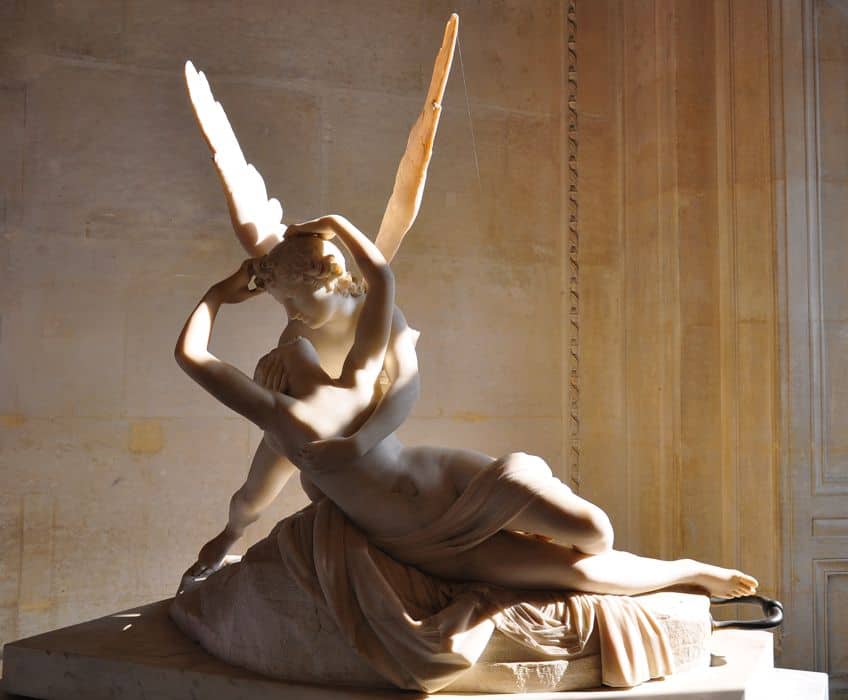
Bather (1757) by Étienne-Maurice Falconet
| Artist Name | Étienne-Maurice Falconet (1716 – 1791) |
| Date | 1757 |
| Medium | Patinated bronze |
| Dimensions (cm) | 63.5 x 22.86 x 22.86 |
| Where It Is Housed | The Louvre Museum, Paris, France |
Étienne-Maurice Falconet was a famous French Baroque Neoclassical sculptor who created many iconic statues, including the bronze horseman statue in St. Petersburg, Russia. Bather is a famous Neoclassical statue by the artist crafted in bronze and forms part of a collection of many other smaller statues that portray a woman disrobing herself to reveal her naked body. Falconet produced several brochures on art and rose to fame after creating The Bather, which is currently housed at the Louvre Museum in Paris. The sensuality of the statue was intended to capture the moment a girl was then seen as a woman in society and reflects, strongly, the gaze of men in society.
The gentle manner in which the figure reaches for the water also indicates the shyness of the young lady.

Venus (1773) by Joseph Nollekens
| Artist Name | Joseph Nollekens (1737 – 1823) |
| Date | 1773 |
| Medium | Marble |
| Dimensions (cm) | 124 x 50.8 x 50.8 |
| Where It Is Housed | J. Paul Getty Museum, Los Angeles, United States |
This Neoclassical Venus sculpture was created by English sculptor Joseph Nollekens to capture the beauty of the goddess as described in ancient mythology. The goddess is seen seated on a tree trunk while she removes her sandal. As she turns inward, she allows the viewer to observe her body and thus admire her beauty through her nakedness and vulnerability. The statue can be viewed from multiple angles and was carved from a satin-like white marble that only amplifies the atmosphere of classical beauty.

The sculptor, Joseph Nollekens trained under a Flemish artist based in London and found employment at the workshop of Bartolomeo Cavaceppi. His primary job was art restoration on sculptures and terracotta pieces by major sculptors like Michelangelo and this is where he gained further insight into how he could perfect his Neoclassical style. His works were favored by the English tourist population in Rome and soon, he joined the Royal Academy as a professional tomb-maker working in marble and plaster.
The Death of Germanicus (c.1774) by Thomas Banks
| Artist Name | Thomas Banks (1735 – 1805) |
| Date | c. 1774 |
| Medium | Marble |
| Dimensions (cm) | 76.2 (h) |
| Where It Is Housed | Holkham Hall & Estate, Norfolk, United Kingdom
|
Thomas Banks was one of the most iconic 18th-century sculptors in England who created this marble masterpiece based on a commission by Thomas Coke, the Earl of Leister who positioned the sculpture at Holkham Hall. According to Nancy Presley, Banks was inspired by the famous painting created by Nicholas Poussin, which shared the same title as well as the now-lost artwork Andromache Mourning the Death of Hector (1761) by Gavin Hamilton. The marble sculpture illustrates Germanicus Julius Caesar, who was the commander of the army in Germania and often referred to as Germanicus. He belonged to the Julio-Claudian dynasty and was one of the most famous generals of the early Roman empire back in 19 CE. The event portrayed in the sculpture occurred in 19 CE and illustrates Germanicus captured at the moment when he was poisoned by his adoptive father who was jealous of him. It is believed that through this sculpture, Banks was expressing his political opinions to solidify the belief in parliamentary reform.
The man who commissioned the sculpture, Coke, was identified as an advocate for the reform bill, thus making the connection very clear.
Father Thames as a River God (1779) by John Bacon
| Artist Name | John Bacon the Elder (1740 – 1799) |
| Date | 1779 |
| Medium | Coade stone and marble |
| Dimensions (cm) | 200 x 220 x 108 |
| Where It Is Housed | National Trust Collection, Ham House, Surrey, United Kingdom |
John Bacon the Elder was one of the most famous British Neoclassical sculptors of all time whose work on Father Thames as a River God at Ham House in Surrey, reflects his mastery over specific sculptural techniques. In the mid-18th century, Bacon took up an apprenticeship in porcelain sculpture and was thereafter employed to paint ornamental fine china. It was not long before he then became a modeler and used his job to improve his technical sculpting skills.

Around 1796, Bacon was awarded a gold medal by the Royal Academy for his work on a bas-relief piece that portrayed Aeneas fleeing from Troy. Another sculpture called Mars (1770) also earned him another gold medal and thus his legacy had been established. The sculpture, Father Thames as a River God, is situated at the entrance of Ham House and is considered to be one of the most unique sculptures in Europe for being one of the few remaining 17th-century sculptures representing themes of power and the century’s fashion.
Diana the Huntress (1782) by Jean-Antoine Houdon
| Artist Name | Jean-Antoine Houdon (1741 – 1828) |
| Date | 1782 |
| Medium | Bronze |
| Dimensions (cm) | 208.3 (h) |
| Where It Is Housed | The Huntington Library, Art Museum, and Botanical Gardens, San Marino, California, United States |
Diana the Huntress is one of the most well-known neoclassical sculptures that stands out from most depictions of Diana in sculpture. Here, she is sculpted as a warrior bearing her bow and arrow in either hand. This powerful Neoclassical statue was created by Jean-Antoine Houdon in 1782 as a commissioned artwork by Jean Girardot de Marigny who was a prominent banker. The goddess of the hunt, Diana, is sculpted in the nude with only a decorative crescent moon hair piece in her hair. This depiction of Diana was uncommon back in the 18th century, thus making the statue a significant Neoclassical piece. The goddess was either sculpted as a fully-clothed huntress or as a bather in the nude.
Here, Houdon combined the two ideal representations of Diana and showcased her power both as a goddess of the hunt and a classical beauty.
Princesses Monument (1795 – 1797) by Johann Gottfried Schadow
| Artist Name | Johann Gottfried Schadow (1764 – 1850) |
| Date | 1795 – 1797 |
| Medium | Plaster and marble |
| Dimensions (cm) | Unavailable |
| Where It Is Housed | Schinkelmuseum (plaster) and Alte Nationalgalerie (marble), Berlin, Germany |
This famous Neoclassicism sculpture by Johann Gottfried Schadow first emerged as two separate busts depicting the two princesses of Prussia. Johann Gottfried Schadow portrayed the two sisters, Frederica and Louis as one life-sized sculpture with one figure resting her arm around the other figure. His first copy was created in plaster and the second copy was then reproduced in marble. Although the artist is not classified as strictly part of the Neoclassical era, his influences were informed by the preceding rococo art style, and chose to represent himself as independent of any art style or movement. He was a free-thinker in a way. The Princesses Monument is recognized as his most famous sculpture, which combines the influence of the rococo style with naturalism and Neoclassical grace.
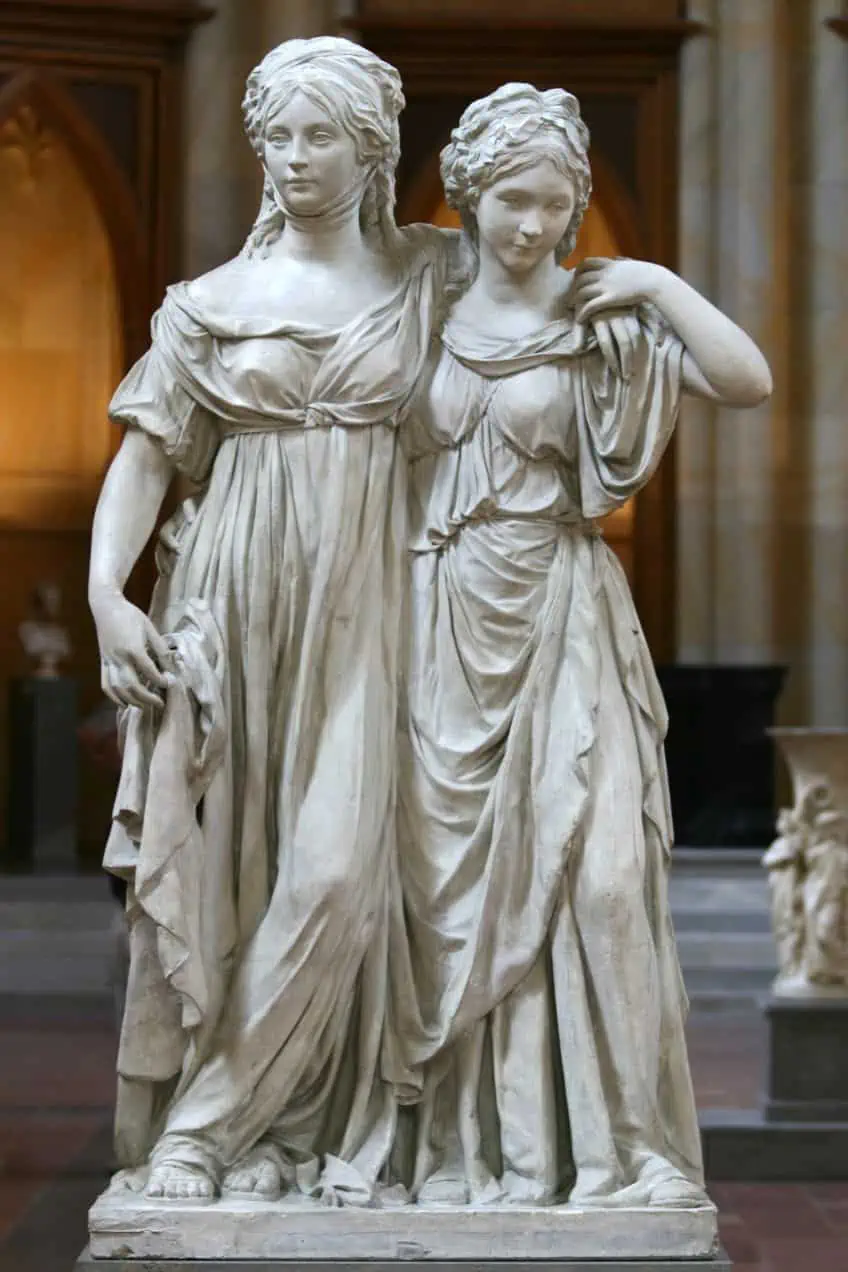
Venus Victrix (1804 – 1808) by Antonio Canova
| Artist Name | Antonio Canova (1757 – 1822) |
| Date | 1804 – 1808 |
| Medium | Plaster |
| Dimensions (cm) | 92 x 200 |
| Where It Is Housed | Museum Gipsoteca Antonio Canova, Possagno, Italy |
This Neoclassical sculpture of the 25-year-old Pauline Bonaparte, Napoleon Bonaparte’s sister, was captured by Italian sculptor, Antonio Canova, who initially thought of naming the sculpture after the mythological figure Diana. Venus Victrix is a portrait sculpture of the princess who was likened to the goddess Venus and appears calm and relaxed on a pile of soft pillows. Her confident demeanor and poised gaze help reinforce the aesthetic of Neoclassical sculptures regarding the portrayal of human emotion and thus captures a version of Pauline Bonaparte in the way in which she wanted to be represented.
Pauline Bonaparte commissioned the piece around 1805 and was a well-known figure among social groups.
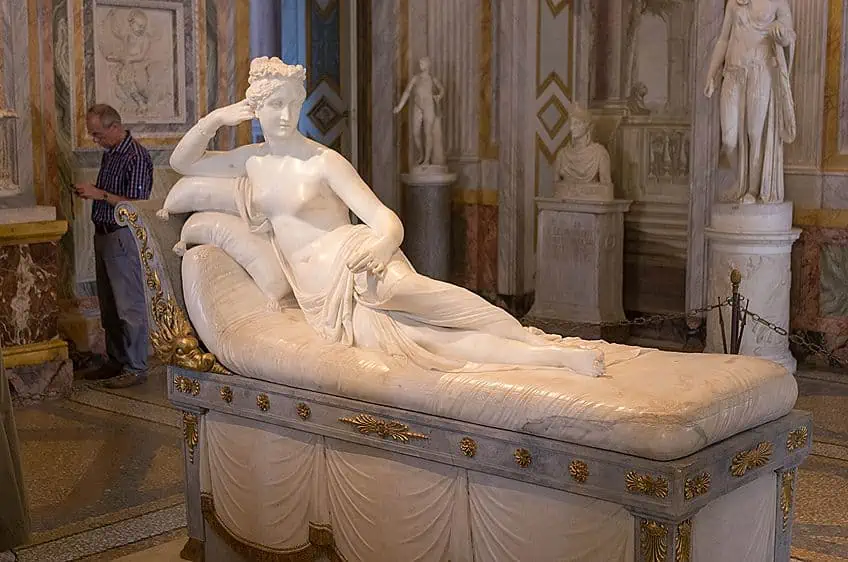
Head of the Nymph (1809) by William Rush
| Artist Name | William Rush (1756 – 1833) |
| Date | 1809 |
| Medium | Pine |
| Dimensions (cm) | 25.4 x 24.13 x 25.4 |
| Where It Is Housed | Pennsylvania Academy of the Fine Arts, Philadelphia, United States |
Head of the Nymph is a fragment of a sculpture that was created by one of the founders of the Pennsylvania Academy’s first charter, William Rush. Rush began his career in sculpture and worked with a subject matter involving the busts of soldiers and heroic figures. Rush is considered to be a pioneering figure in American sculpture and is best known for his wooden sculptures coated in a layer of white paint to mimic the aesthetic of antique sculpture. Other famous sculptural contributions by Rush include The Schuylkill Chained and The Schuylkill Freed sculpture for the Philadelphia Center Square. The original wooden sculpture of the nymph is no longer available and only her head remains. It is believed that the sculpture was carved from a live model by the name of Louisa Vanuxem.

St. Michael Overcoming Satan (1819 – 1824) by John Flaxman
| Artist Name | John Flaxman (1755 – 1826) |
| Date | 1819 – 1824 |
| Medium | Plaster |
| Dimensions (cm) | 344 (h) |
| Where It Is Housed | Flaxman Gallery, UCL, London, United Kingdom |
This massive three-meter-high Neoclassical sculpture is one of the most famous creations of British sculptor John Flaxman. Flaxman was incredibly talented in creating funerary monuments and also spent a significant amount of time as a book illustrator. St. Michael Overcoming Satan portrays St. Michael with a long spear in his hand, about to strike Satan. According to Catholic belief, St. Michael is one of God’s warrior angels who is regarded as the “chief warrior” in the battle against the devil.
The sculpture is recognized as Flaxman’s last great masterpiece and is certainly one to marvel at for its heroic display of divine justice.
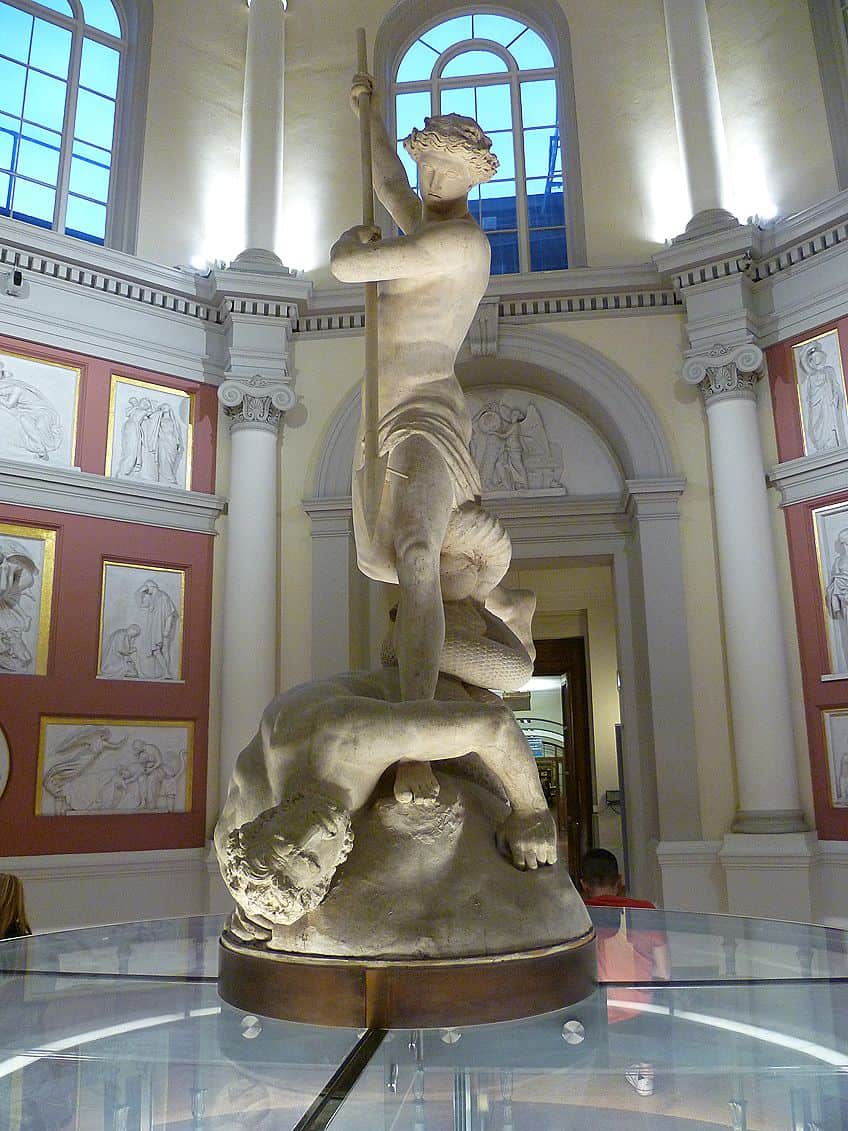
Monument of Józef Poniatowski (1826 – 1827) by Bertel Thorvaldse
| Artist Name | Bertel Thorvaldse (1770 – 1884) |
| Date | 1826 – 1827 |
| Medium | Bronze |
| Dimensions (cm) | Unavailable |
| Where It Is Housed | Krakowskie Przedmieście 46/48, Warszawa, Poland |
Located in the courtyard of the presidential palace, this Neoclassical sculpture stands tall and is one of the best examples of a Neoclassical equestrian statue. The statue portrays prince Józef Poniatowski riding a horse and was commissioned by the Danish sculptor Bertel Thorvaldsen in 1829. The prince is portrayed as a Roman general bearing a stern expression. The history of the sculpture involves Anna Potocka, a Polish aristocrat who obtained permission from the Tsar to position the sculpture in the presidential palace. In 1829, the first sculpture was exhibited in Warsaw in Classist form but the sculpture received a lot of negative feedback from art critics due to its representation as being “half-naked”, which did not meet the expectations of the public who wished to see a fully-armored warrior.

In 1832, a bronze cast was made at the Klaudiusz and Emil Gregoire foundry, which was then transported to the Modlin Fortress. In 1836, the sculpture was then dismantled and then reassembled in 1840 after being stored in 10 boxes. After an inspection by Tsar Nicholas I, it was decided that the sculpture would be scrapped, but for some unknown reason, it was spared. Between 1842 and 1922, the statue found a home at the Paskevich Palace in Gomel, and thereafter it was moved in 1922 to replace another monument that was taken down following the independence of Poland. The statue occupied the Royal Castle in Saxon Square, but its journey soon came to an end in 1944. On 16 December, the statue was destroyed on command of Erich von dem Bach-Zelewski, the then-German general, and a new copy was cast between 1948 and 1951. The new copy was created by Poul Lauritz Rasmussen and then moved to its current location in 1965. Talk about a tumultuous history!
Lesbia and Her Sparrow (1836) by Johann Heinrich Von Dannecker
| Artist Name | Johann Heinrich Von Dannecker (1758 – 1841) |
| Date | 1836 |
| Medium | Marble on a later painted wood base |
| Dimensions (cm) | Marble: 91 x 71 x 31.5 and base: 80.5 x 80 |
| Where It Is Housed | Sotheby’s; Greenford Park Warehouse |
This gentle marble sculpture is one of the most famous Neoclassical statues created by Johann Heinrich Von Dannecker, who was one of Germany’s most famous Neoclassical sculptors. Von Dannecker was the son of one of the Duke of Württemberg’s coachmen and first joined the academy at the young age of 13 where he was introduced to sculpture. After his graduation, he traveled to Paris and Rome where his approach to sculpture was greatly influenced by the aesthetics of Antonio Canova. Von Dannecker was encouraged to explore his skills with non-commissioned sculptures and perfect his Neoclassical style. In 1789, he returned to Stuttgart where he married his wife Heinrike Rapp and then proceeded to create Lesbia and Her Sparrow. The inspiration for the sculpture came from an idyll by a Roman poet called Catullus who wrote a poem about his lover, Lesbia, and her pet who she often enjoyed playing with – the sparrow.
Later on, the sparrow passed away and left the girl saddened. Her expression bears a familiar feeling of grief that is presented in a calm acceptance as she holds the sparrow’s lifeless body in her palm.
George Washington (1841) by Horatio Greenough
| Artist Name | Horatio Greenough (1805 – 1852) |
| Date | 1841 |
| Medium | Marble |
| Dimensions (cm) | 350 x 260 |
| Where It Is Housed | National Museum of American History, Washington, D.C., United States |
This 12-tonne sculpture by Horatio Greenough is one of the most famous American Neoclassical artworks in art history, commissioned by the United States Congress in 1832. Greenough was recognized as the first professionally-trained American artist to receive a federal commission. Thus, the George Washington statue was a commemorative artwork for the centennial of the first president’s birthday, which took a total of eight years to accomplish. The Neoclassical style was also incredibly relevant to the function of the artwork since it paid homage to ancient Greece, which was the first democratic society in the world. Other carvings found on the side of the sculpture include illustrations of Apollo, a baby Hercules, an American Indian, and the figure of Christopher Columbus to represent a culmination of the “old and new” world. Washington is seen holding a sword in his hand, which is a symbol of how he relinquished his power to the people.

Nydia, the Blind Flower Girl from Pompeii (1853 – 1854) by Randolph Rogers
| Artist Name | Randolph Rogers (1825 – 1892) |
| Date | 1853 – 1854 |
| Medium | Marble |
| Dimensions (cm) | 143 x 61 x 84 |
| Where It Is Housed | High Museum of Art, Atlanta, Georgia, United States |
This marble Neoclassical statue is one of Randolph Rogers’ best sculptures from the mid-19th century that portrays a young flower girl named Nydia from Pompeii. The character originated from a novel written by English writer Edward Bulwer-Lytton, The Last Days of Pompeii (1834), in which Nydia is escaping from the eruption of Mount Vesuvius while searching for her lost family. Nydia was a symbol of sacrifice and bravery in the face of one of the greatest disasters of the ancient world. Nydia, the Blind Flower Girl from Pompeii is thus regarded as one of the best American Neoclassical sculptures in art history. Its sculptor, Randolph Rogers, was an American expatriate who spent most of his career in Italy. Rogers first started his artistic career carving sculptures of children and busts of tourists and Nydia, the Blind Flower Girl from Pompeii is known as his second-largest marble sculpture.
His studio ended up reproducing over 77 replicas due to the positive reception of the work and its affiliation with Bulwer-Lytton’s best-seller.
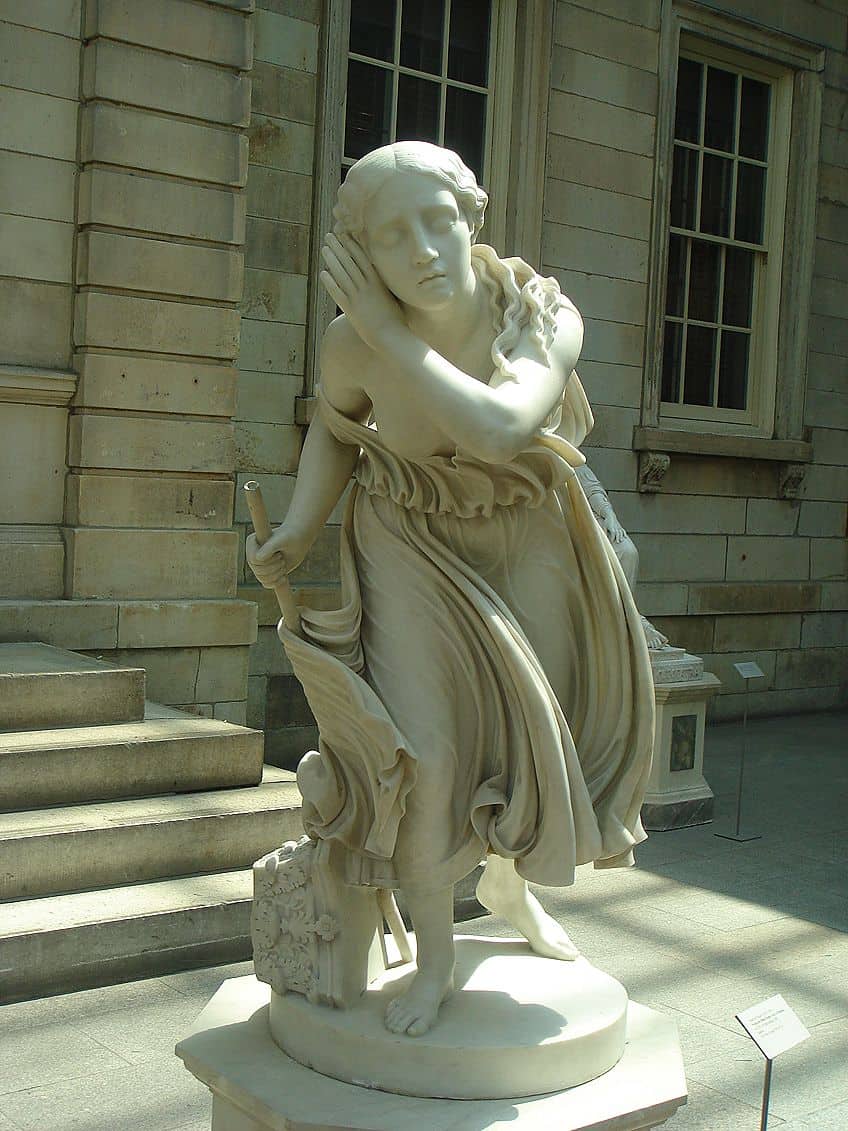
The Greek Slave (1869) by Hiram Powers
| Artist Name | Hiram Powers (1805 – 1873) |
| Date | 1869 |
| Medium | Marble |
| Dimensions (cm) | 165.7 x 53.3 x 46.4 and base: 76.8 |
| Where It Is Housed | Brooklyn Museum, Brooklyn, New York City, United States |
The Greek Slave is perhaps one of the most famous Neoclassical statues of all time that portrays a Greek female slave in the nude. The sculpture was modeled by 19th-century American artist Hiram Powers who presented the idealized nude in a contrapposto pose. The hands of the slave appear bound with chains and one hand over her genitalia as she turns to the left-hand side, as if in quiet shame or modesty. Powers gained his legacy in sculpture through his female nude sculptures with The Greek Slave inspired by the Medicean Venus.
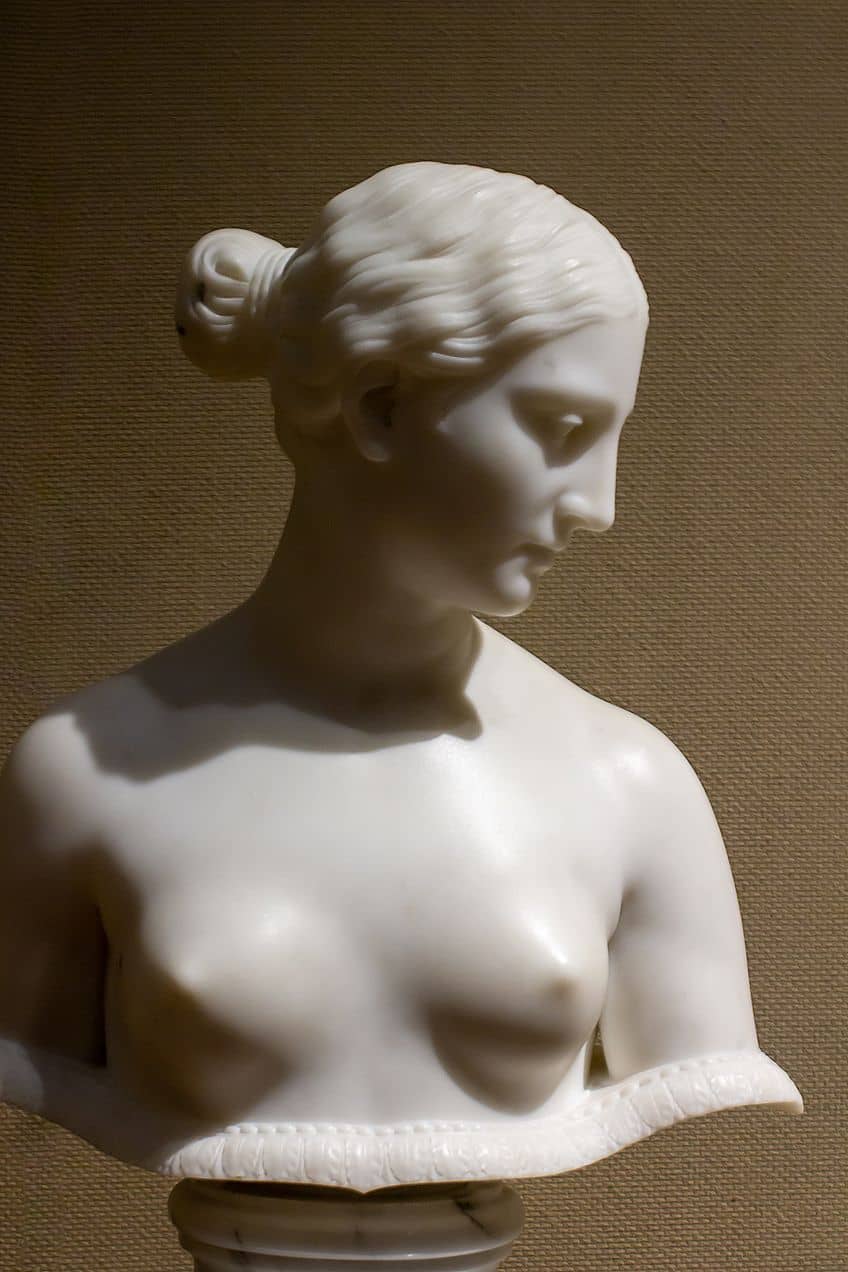
Daniel Webster (1858) by Hiram Powers
| Artist Name | Hiram Powers (1805 – 1873) |
| Date | 1858 |
| Medium | Bronze on a granite base |
| Dimensions (cm) | Unavailable |
| Where It Is Housed | Massachusetts State House, Boston, Massachusetts, United States |
This bronze statue of statesman Daniel Webster is one of the most famous Neoclassicism sculptures in Northern America. The statue was created by Hiram Powers who was among the first few American Neoclassical sculptors to gain global recognition. One of his most famous contributions is The Greek Slave, which was created prior to Daniel Webster. Following the September 11 attacks in 2001, public access to the sculptures at the State House was restricted.
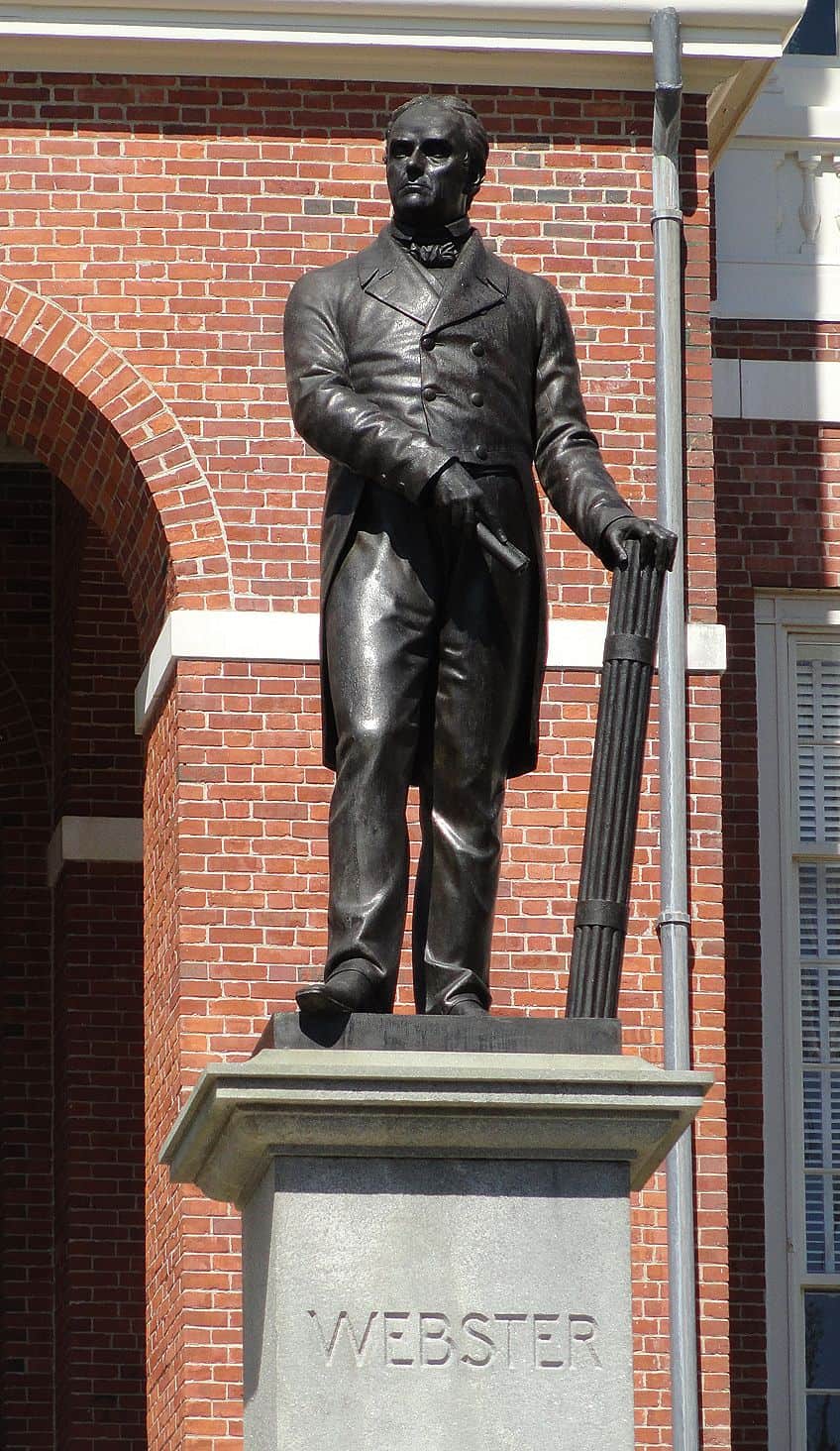
Neoclassicism was a branch of the tree of Classicism that saw the careful selection and curation of myths and inspirational stories carried over from ancient Greek and Roman art. A longing for the classical beauty and elegance of past times drove many Neoclassicists to explore the ways that they could re-sculpt those narratives into 18th-century society and cater to a very niche market. We hope that this article has helped you learn more about the art styles of Neoclassicism sculptures and the different ways in which it has been realized in art history.
Frequently Asked Questions
What Is Neoclassicism?
Neoclassicism refers to a niche Western art style that dominated the 18th and 19th centuries in the visual arts. Neoclassicism was not only a style that influenced the visual arts, but it also spanned the spheres of architecture, literature, music, and theater. The foundation of the cultural movement was based on the aesthetics promoted by the ancient Greek and Roman worlds.
What Are the Main Characteristics of Neoclassicism?
The main characteristics of Neoclassicism include the use of sober colors, classical subject matter, clear form, and strong verticals and horizontals. Neoclassicism was influenced by the Age of Enlightenment, which privileged rational thinking and dimmed down the qualities of Baroque-styled artworks. The major themes of Neoclassicism also included restraint and common sense.
Who Is the Most Famous Neoclassical Sculptor?
The most famous Neoclassical sculptor is considered to be Antoni Canova, who operated in the 18th century and early 19th century. His most famous Neoclassical sculptures include Psyche Revived by Cupid’s Kiss (1793), Venus Victrix (1808), and The Three Graces (1814 – 1817).
Nicolene Burger, a South African multimedia artist and creative consultant, specializes in oil painting and performance art. She earned her BA in Visual Arts from Stellenbosch University in 2017. Nicolene’s artistic journey includes exhibitions in South Korea, participation in the 2019 ICA Live Art Workshop, and solo exhibitions. She is currently pursuing a practice-based master’s degree in theater and performance. Nicolene focuses on fostering sustainable creative practices and offers coaching sessions for fellow artists, emphasizing the profound communicative power of art for healing and connection. Nicolene writes blog posts on art history for artfilemagazine with a focus on famous artists and contemporary art.
Learn more about Nicolene Burger and about us.
Cite this Article
Nicolene, Burger, “Famous Neoclassical Sculptures – Explore Neoclassical Statues.” artfilemagazine – Your Online Art Source. February 14, 2023. URL: https://artfilemagazine.com/famous-neoclassical-sculptures/
Burger, N. (2023, 14 February). Famous Neoclassical Sculptures – Explore Neoclassical Statues. artfilemagazine – Your Online Art Source. https://artfilemagazine.com/famous-neoclassical-sculptures/
Burger, Nicolene. “Famous Neoclassical Sculptures – Explore Neoclassical Statues.” artfilemagazine – Your Online Art Source, February 14, 2023. https://artfilemagazine.com/famous-neoclassical-sculptures/.


